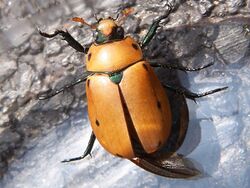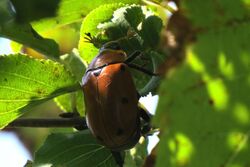Biology:Grapevine beetle
| Grapevine beetle | |
|---|---|

| |
| Scientific classification | |
| Domain: | Eukaryota |
| Kingdom: | Animalia |
| Phylum: | Arthropoda |
| Class: | Insecta |
| Order: | Coleoptera |
| Family: | Scarabaeidae |
| Genus: | Pelidnota |
| Species: | P. punctata
|
| Binomial name | |
| Pelidnota punctata | |
The grapevine beetle (Pelidnota punctata), also known as the spotted June beetle or the spotted pelidnota, is a species of beetle in the family Scarabaeidae (Scarab beetles), situated in the subfamily Rutelinae. Grapevine beetles are common in the north and central United States and eastern Canada, but do relatively little damage to their host plants. The beetles fly at a fast speed, usually in a curving flight.
The adult beetle is approximately 2.5 centimetres (1 inch) long, but can reach 3 cm (1.2 in) occasionally. Its pattern is off-yellow or auburn red, with four black spots running down each side. Fine black lines divide the edges of its elytra. There are two different variations of Pelidnota punctata: the southern variation lacks the darker legs, while the northern variation has darker legs. Adults in the northern parts of its range will have darker and more spots, while those in the southern regions may not have them at all.[1] The grapevine beetle is a variable species, whose taxonomy and nomenclature has been discussed and revised throughout the twentieth century.[2]
Habitat and diet
The beetle lives throughout the eastern part of North America, from Ontario and Maine in the north to Florida in the south, and west to Texas and South Dakota.[1] It lives, like many beetles, in forests, thickets, and woods, and is mostly seen during the summer. Active flyers, these beetles are commonly attracted to lights at night. It is also seen in vineyards and gardens.[citation needed]
The adult beetle eats the leaves and fruit of grapevines, both wild and cultivated, although it is not normally a major pest of vineyards.
Beetle eggs are laid in rotten wood, tree stumps, or on soil near the host plant, where they hatch into larvae, which may grow up to two inches long.[3] Larvae then dig their way into the soil, where they feed on rotted wood. Pupal chambers are built shallowly underground. The adults emerge in July.[4] Its complete life cycle is two years.[1]
References
- ↑ 1.0 1.1 1.2 Evans, Arthur V. (2014). Beetles of Eastern North America. Princeton University Press. pp. 169. ISBN 978-0691133041.
- ↑ Moore, Matthew R.; Jameson, Mary L.; Garner, Beulah H.; Audibert, Cedric; Smith, Andrew B. T.; Seidel, Matthias (6 April 2017). "Synopsis of the pelidnotine scarabs (Coleoptera, Scarabaeidae, Rutelinae, Rutelini) and annotated catalog of the species and subspecies". ZooKeys (666): 1–349. doi:10.3897/zookeys.666.9191. PMID 28769631.
- ↑ "Grapevine Beetle (Family Scarabaeidae". 28 August 2012. https://uwm.edu/field-station/grapevine-beetle/.
- ↑ Milne, Lorus, and Margery Milne (2000). National Audubon Society Field Guide to North American Insects and Spiders. New York: Knopf. 989 pp. ISBN:0-394-50763-0.
External links
- Pelidnota punctata - Grapevine Beetle, BugGuide
- Grapevine beetle diagnostic reference photos and information
Wikidata ☰ Q2551260 entry


